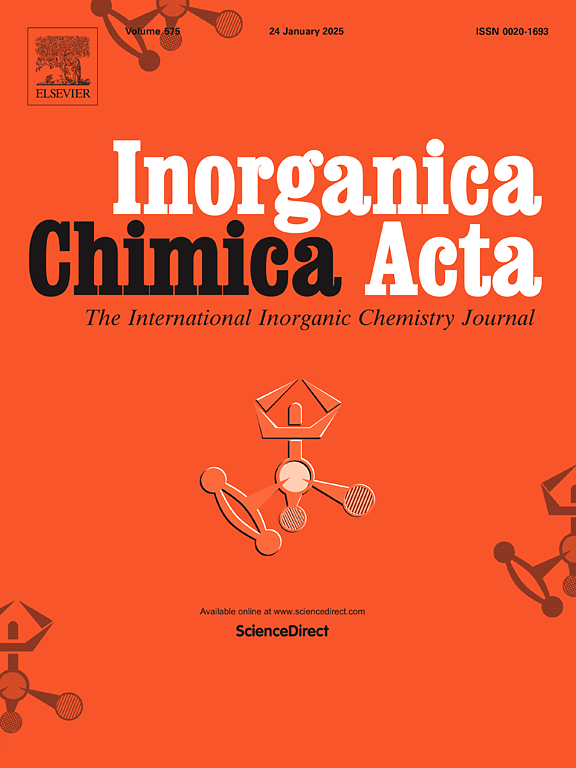二吡啶酸配位新型Cu+2配合物的dna相互作用及抗癌活性研究。实验与计算研究
IF 3.2
3区 化学
Q2 CHEMISTRY, INORGANIC & NUCLEAR
引用次数: 0
摘要
[Cu(dmpn)2(OH2)][Cu2(DPA)4μ-Cu(dmpn)2]。合成了H2O(1),其中dmpn为2,2′-二甲基-1,3-二氨基丙烷,DPA为二吡啶酸(H2dipic),并通过x射线晶体学、电导率测量、热重(TG)分析、光谱方法(IR、Mass、UV-Vis、EPR)对其进行了表征。用振动样品磁强计(VSM)研究了配合物(1)在室温下的磁性能。结果表明,该配合物具有顺磁性。与已知的抗癌药物如顺铂相比,复合物(1)最初的体外细胞毒活性显示出对HCT116结肠细胞系有希望的效果。在最近的研究中,利用不同的技术探索了DNA与复合体(1)之间的相互作用模式。实验表明,荧光猝灭的机理是静态的,而这种相互作用的特点是放热的。表观结合常数(Kapp = 1.9 × 103 M−1)表明Cu(II)配合物与DNA的相互作用可能是非插层的。根据其他数据,可以提出氢键和范德华力在这种相互作用中起主要作用。分子对接模拟支持了实验结果。同样,复合体(1)在H2O2存在下显示出核酸酶活性,并能切割DNA结构。本文章由计算机程序翻译,如有差异,请以英文原文为准。

Investigating DNA-interaction and anticancer activity of new Cu+2 complex coordinated with dipicolinic acid. Experimental and computational studies
A complex formulized as [Cu(dmpn)2(OH2)][Cu2(DPA)4μ-Cu(dmpn)2].H2O (1), where dmpn is 2,2′-dimethyl-1,3-diaminepropane and DPA is dipicolinic acid (H2dipic), was synthesized and characterized by X-ray crystallography, conductivity measurement, thermogravimetric (TG) analysis, spectroscopic methods (IR, Mass, UV–Vis, EPR). Magnetic properties of complex (1) were studied at room temperature with vibrating sample magnetometer (VSM). The results indicated that the complex exhibits paramagnetic behavior. The initial in vitro cytotoxic activity of complex (1) showed promising results against HCT116 colon cell lines compared to the known anticancer drugs such as cisplatin. In the recent study, the mode of interaction between DNA and complex (1) was explored using different techniques. The experiments revealed that the mechanism of fluorescence quenching is static and the characteristic of this interaction is exothermic. The apparent binding constant (Kapp = 1.9 × 103 M−1) shows that the interaction between the Cu(II) complex and DNA is probably non-intercalation. Based on other data, it can be suggested that hydrogen bonding, and van der Waals forces play a major role in this interaction. Molecular docking simulation supported the achieved experimental results. Likewise, complex (1) shows nuclease activity in the presence of H2O2 and can cleavage the structure of DNA.
求助全文
通过发布文献求助,成功后即可免费获取论文全文。
去求助
来源期刊

Inorganica Chimica Acta
化学-无机化学与核化学
CiteScore
6.00
自引率
3.60%
发文量
440
审稿时长
35 days
期刊介绍:
Inorganica Chimica Acta is an established international forum for all aspects of advanced Inorganic Chemistry. Original papers of high scientific level and interest are published in the form of Articles and Reviews.
Topics covered include:
• chemistry of the main group elements and the d- and f-block metals, including the synthesis, characterization and reactivity of coordination, organometallic, biomimetic, supramolecular coordination compounds, including associated computational studies;
• synthesis, physico-chemical properties, applications of molecule-based nano-scaled clusters and nanomaterials designed using the principles of coordination chemistry, as well as coordination polymers (CPs), metal-organic frameworks (MOFs), metal-organic polyhedra (MPOs);
• reaction mechanisms and physico-chemical investigations computational studies of metalloenzymes and their models;
• applications of inorganic compounds, metallodrugs and molecule-based materials.
Papers composed primarily of structural reports will typically not be considered for publication.
 求助内容:
求助内容: 应助结果提醒方式:
应助结果提醒方式:


